
Borneo is the third-largest island in the world and the largest in Asia. At the geographic centre of Maritime Southeast Asia, in relation to major Indonesian islands, it is located north of Java, west of Sulawesi, and east of Sumatra.

North Borneo was a British protectorate in the northern part of the island of Borneo, which is present day Sabah. The territory of North Borneo was originally established by concessions of the Sultanates of Brunei and Sulu in 1877 and 1878 to a German-born representative of Austria-Hungary, a businessman and diplomat, Gustav Overbeck.

The Raj of Sarawak, also State of Sarawak, located in the northwestern part of the island of Borneo, was an independent state with a treaty of protection with United Kingdom starting from 1888. It was established as an independent state from a series of land concessions acquired by an Englishman, James Brooke, from the Sultan of Brunei. Sarawak received recognition as an independent state from the United States in 1850, and from the United Kingdom in 1864. The area now forms the Malaysian state of Sarawak.
Chiropodomys is a genus of Old World rats and mice native to Southeast Asia and northeast India. They are tree-dwelling, very small mice, mostly found in tropical rainforest. In total six extant species have been identified, but only one of these, Chiropodomys gliroides, is common and widely distributed, and has been extensively studied.

Theretra silhetensis, the brown-banded hunter hawkmoth, is a moth of the family Sphingidae described by Francis Walker in 1856. It lives in Indo-Australia, India, Sri Lanka, Papua New Guinea, East Australia, Solomon Islands, Fiji Islands, Vanuatu Islands.
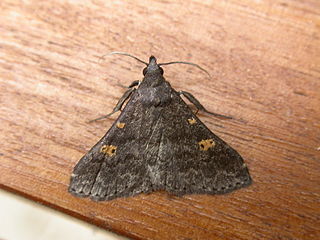
Naarda is a large genus of erebid moths currently encompassing 108 species. Initially identified by Francis Walker in 1866, it is in the family Erebidae. Somewhat ruddy in appearance, this genus is distinguishable for its generally slender thorax and abdomen, and straight, porrect labial palpi. Most species are a light tan color, but shading can reach as deep as a charcoal, with muddy yellow, conspicuous reniform, orbicular stigmata featured on the forewings, sometimes reflected bilaterally superior.

Pangrapta is a genus of moths in the family Erebidae. The genus was erected by Jacob Hübner in 1818.

Nygmia is a genus of tussock moths in the family Erebidae. The genus was erected by Jacob Hübner in 1820.
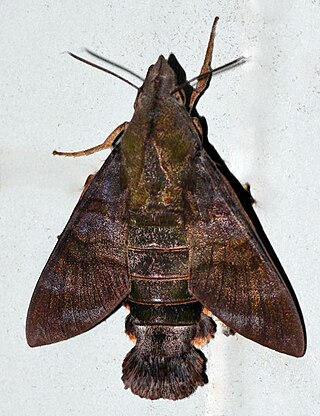
Macroglossum corythus is a species of hawk moth of the family Sphingidae. It was described by Francis Walker in 1856 and is found throughout the Indo-Australian tropics east to New Caledonia.

Macroglossum divergens, the broad-bordered hummingbird hawkmoth, is a moth of the family Sphingidae. It was described by Jean Baptiste Boisduval in 1875. It is found from north-eastern Sikkim, India across southern China to Cheju Island, southern Japan, Taiwan and the Philippines and then south through Vietnam, Thailand, Malaysia and Indonesia to New Guinea and neighbouring islands. It may be in Sri Lanka.

Trabala is a genus of moths in the family Lasiocampidae described by Francis Walker in 1856.
Idiochlora is a genus of moths in the family Geometridae. The genus was described by Warren in 1896.
Orthostixinae is a subfamily of the moth family Geometridae. It was described by Edward Meyrick in 1892.
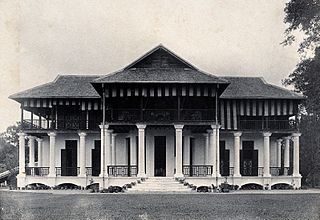
Borneo Company Limited, formed in 1856, was one of the oldest companies based in East Malaysia.
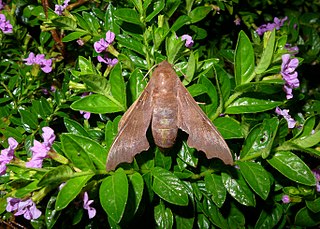
Cypa decolor is a species of moth of the family Sphingidae first described by Francis Walker in 1856.

Risoba is a genus of moths of the family Nolidae erected by Frederic Moore in 1881.
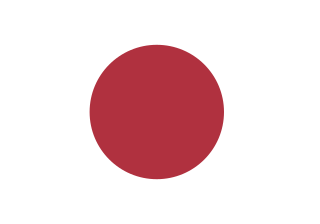
Before the outbreak of World War II in the Pacific, the island of Borneo was divided into five territories. Four of the territories were in the north and under British control – Sarawak, Brunei, Labuan, an island, and British North Borneo; while the remainder, and bulk, of the island, was under the jurisdiction of the Dutch East Indies.

Longicella mollis is a species of moth of the family Noctuidae first described by Francis Walker in 1856.
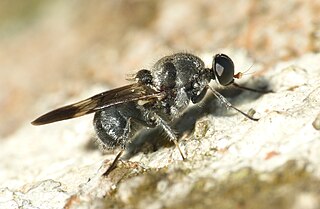
Culcua is a genus of flies in the family Stratiomyidae.that are found only in the Indomalayan realm. About eleven species have been described. They have a disc-shaped flagellum to the antenna and have a arista or hair arising from it. The scutellum typically has four strong spines and the abdomen is nearly spherical

Ledra is the type genus of leafhoppers in the subfamily Ledrinae and the tribe Ledrini. Ledra aurita can be found in Europe but most species occur in Asia.

















